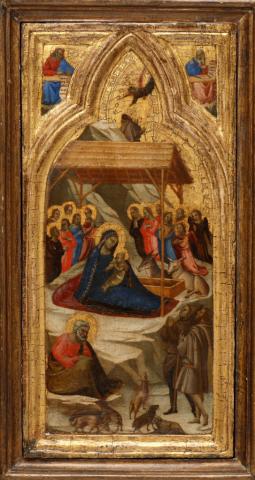Nativity
Gaddi, Taddeo (Florentine painter, active mid-1320s, died 1366)
Nativity
Italian (Florence), ca. 1325-1345
Late Medieval
paint and gold leaf on panel
height 35.9 cm
width 44.2 cm
Portland Art Museum European Collection, 69.68
Gift of Mrs. Charlotte A. Maser
Elizabeth Schultz, Medieval Portland Capstone Student, Winter 2005
Taddeo Gaddi's Nativity is a panel piece with polychrome and gold leaf. This work, which was probably once a section of a portable triptych, is nearly identical to an earlier, and much larger, triptych by Taddeo that belongs to the Kaiser Friedrich Museum of Berlin. The layout of the Nativity is similar to many other works created during the time period. The piece features Mary, slightly off center and to the left, cradling the newborn Jesus in her arms, while most of the figures, representing the various saints, are gathered behind her. Joseph is positioned in the foreground, also to the left, and is looking away from the events that are occurring just behind him. These characters are by far the most colorful in the panel. Golden halos surround the heads of these brightly clothed individuals, whereas the peasants in the right foreground lack these heavenly auras and wear merely brown rags. Two evangelists inhabit the top left- and right-hand corners of the panel, also known as the spandrels, which is common amongst several other Nativity paintings of the period. Such religious scenes were frequent subjects of art pieces during the period. However, this work contains two small figures, an angel and a shepherd in the top center of the panel, which are not present in all versions. Bernado Daddi, a peer of Taddeo's, painted a similar Nativity, currently located in the Bigallo collection of Florence, which omits these two figures.
The Nativity was created in Florence during the 14th century, about a century before the Renaissance period began. This century was marked by the arrival of the black plague in Florence in the year 1348, resulting in the deaths of nearly half the population of the city. Other important events of the period include the Medici family coming into power in Florence, and the devastating flood that occurred in 1333.
Background Essay: Taddeo Gaddi
The Italian artist Taddeo Gaddi (1300 - 1366) painted several panel pieces during his career, yet most of them were done in the 1330s. However, he is most well known for his numerous frescoes in Pisa and Florence. Taddeo belonged to a very influential Florentine family with a long tradition of artistic involvement. His father, Gaddo Gaddi, was a well-known painter and mosaicist, and three of Taddeo's five sons went on to continue the family tradition. Taddeo also had the distinct advantage of being godson and apprentice to the famed artist Giotto di Bondone. He studied and assisted in Giotto's workshop for approximately twenty-four years until the death of Giotto in 1337.
Taddeo Gaddi has frequently been compared to his teacher throughout history. Although most critics agree that Taddeo did not have the overall skill of Giotto, the Renaissance writer Giorgio Vasari observes of Taddeo: It may be observed that he constantly adhered to the manner of Giotto, but we cannot affirm that he greatly improved that manner, except in the coloring, to which he gave more freshness and animation than had been exhibited by Giotto.[1] Taddeo's talent was also recognized during his lifetime. In 1347, he was honored with the title of best painter by the city of Florence.
The earliest works of Taddeo that still exist include several murals painted for the Baroncelli chapel of Santa Croce. This chapel also included pieces by Giotto and two fellow students of Taddeo, Bernado Daddi and Maso di Banco. Other notable works of Taddeo Gaddi include The Stigmatization of Saint Francis (ca. 1325 - 1330), Life of the Virgin (ca. 1328 - 1330), The Angelic Announcement to the Shepherds (ca. 1328 - 1330), and Madonna and Child Enthroned (ca. 1355). The many remaining works and documents pertaining to Taddeo Gaddi demonstrate that he was a very prolific and successful artist throughout his life.
Artists in this era received much recognition and were often commissioned by wealthy patrons to create altarpieces and other religious works. Architecture was also a way for many artists to obtain wealth. After the flood, several Florentine bridges were in desperate need of reconstruction. The first to be rebuilt, the Ponte alla Carraia, was designed by Giotto di Bondone. Taddeo soon followed his master's lead and reconstructed the Ponte Vecchio in 1345 using a design very similar to Giotto's.
Notes
[1] Giorgio Vasari, Lives of Seventy of the Most Eminent Painters, Sculptors and Architects. (New York: The Scribner Press, 1923), 127.
Suggestions for Further Reading
- Ladis, Andrew. Taddeo Gaddi: critical reappraisal and catalogue raisonne. Columbia: University of Missouri Press, 1982.
- Sir, Osvald. Giotto and some of his followers. New York: Hacker Art Books, 1975.

